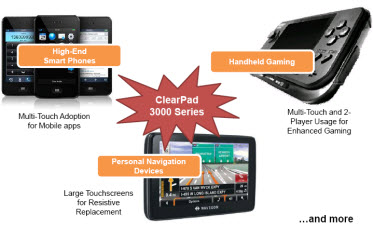 The Apple iPhone popularized the multitouch screens that you can swipe with your hands, but the underlying technology came from Synaptics, which supplied the touch-based components that made it possible to control a phone’s features with two-finger gestures such as a swipe or a pinch.
The Apple iPhone popularized the multitouch screens that you can swipe with your hands, but the underlying technology came from Synaptics, which supplied the touch-based components that made it possible to control a phone’s features with two-finger gestures such as a swipe or a pinch.
Now the multitouch screen is taking a big leap forward with more complex gestures. Thanks to advances like this, the market for touchscreens with multi-touch capability is expected to grow from $800 million in 2008 to over $4 billion in 2015, according to market researcher DisplaySearch.
 Synaptics is announcing today that it can now let you control a touch screen with all 10 of your fingers. The touchscreens enabled with the Synaptics ClearPad 3000 Series controls will be able to detect 10 independent taps on a screen at the same time. Synaptics will introduce the components in November. This advance will lead to big leaps in the cell phones and other gadgets coming later in the year or in early 2010. The gesture detection is accurate to within a millimeter, much better than before.
Synaptics is announcing today that it can now let you control a touch screen with all 10 of your fingers. The touchscreens enabled with the Synaptics ClearPad 3000 Series controls will be able to detect 10 independent taps on a screen at the same time. Synaptics will introduce the components in November. This advance will lead to big leaps in the cell phones and other gadgets coming later in the year or in early 2010. The gesture detection is accurate to within a millimeter, much better than before.
With the newer, more accurate gesture detection, cell phone makers will be able to sport gadgets with more accurate touchscreen typing. For instance, when you tap two letters in rapid succession on an iPhone screen now, the screen will often register only a single tap. The older two-finger touch technology will now be called the ClearPad 2000 Series, and a low-cost version will be called the ClearPad 1000 Series.
June 5th: The AI Audit in NYC
Join us next week in NYC to engage with top executive leaders, delving into strategies for auditing AI models to ensure fairness, optimal performance, and ethical compliance across diverse organizations. Secure your attendance for this exclusive invite-only event.
 With the ClearPad 3000 Series, there are new gesture-based controls that add convenience. When you want to toss out an email, you could use three fingers to take a message and crumple it up, much like you do with a real piece of paper. Andrew Hsu, a product marketing director at Synaptics in Santa Clara, Calif., said the technology works on screens that are up to eight inches in diameter. That means it could be used in netbooks, computers that are smaller than traditional laptops.
With the ClearPad 3000 Series, there are new gesture-based controls that add convenience. When you want to toss out an email, you could use three fingers to take a message and crumple it up, much like you do with a real piece of paper. Andrew Hsu, a product marketing director at Synaptics in Santa Clara, Calif., said the technology works on screens that are up to eight inches in diameter. That means it could be used in netbooks, computers that are smaller than traditional laptops.
Synaptics is also announcing its 1000 Series product where you can use a touchscreen without its traditional border surrounding the edge of a screen. The 1000 Series is limited to one-finger or two-finger touch. Synaptics, by the way, is not allowed to talk about Apple as a customer. But most industry observers have figured out that Apple uses Synaptics in lots of products.
